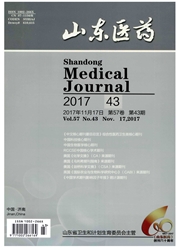

 中文摘要:
中文摘要:
目的观察经尿道灌注干细胞白血病(SCL)基因重组慢病毒的糖尿病膀胱病(DCP)豚鼠膀胱Cajal样间质细胞(ICC)的数量、分布及超微结构变化。方法构建SCL基因重组慢病毒且标定滴度。选择雄性豚鼠70只,单次腹腔注射链尿佐菌素12周后构建DCP豚鼠模型,将成功造模的27只豚鼠随机分为实验组、阳性对照组、空白对照组,每组9只。实验组、阳性对照组、空白对照组豚鼠分别经尿道灌注(转染)SCL基因重组慢病毒、空慢病毒和等量PBS液。分别于转染后7、14、28 d每组各处死3只豚鼠,取膀胱组织,制作切片,激光共聚焦显微镜下观察GFP表达、膀胱ICC数量及分布变化,透射电镜下观察膀胱ICC的超微结构变化。结果实验组随转染时间延长,ICC数量逐渐增多(P均〈0.01),分布越发密集,但绿色荧光逐渐减退;空白组和对照组未见绿色荧光,随转染时间延长,ICC数量逐渐减少(P均〈0.05),分布稀疏;转染14、28 d时,实验组ICC数量较空白组和对照组增加(P均〈0.01)。实验组随转染时间延长,ICC细胞器数量增多,形态趋于正常,细胞内空泡减少,胞周突起延长变多,ICC超微结构处于不断恢复之中;而阳性对照组和空白对照组ICC超微结构病理变化逐渐加重。结论经尿道灌注SCL基因重组慢病毒转染DCP豚鼠膀胱后,膀胱ICC数量增多,分布更加密集,细胞超微结构得到修复,提示SCL基因对DCP可能有一定治疗效果。
 英文摘要:
英文摘要:
Objective To observe morphological changes in the number, distribution and ultrastructure of interstitial cells of Cajal ( ICC ) in guinea pig with diabetic cystopathy (DCP) after transurethral perfusion of stem cell leukemia (SCL) gene recombinant lentiviral Vector. Methods We constructed the recombinant lentiviral vector of SCL gene and demarcated its titer. Seventy guinea pigs were selected and a single intraperitoneal injection of streptozotocin (STZ) was used to construct the DCP models of guinea pigs at the end of the 12th week. Twenty;seven successful DCP models of guinea pigs were randomly divided into the experimental group, positive control group and blank control group (n = 9 in each group). The experimental group, the positive control group and the blank control group were injected with SCL gene recombinant lentivirus, empty lentivirus and the same amount of PBS solution, respectively. On day 7, 14 and 28 after transfection, 3 guinea pigs were sacrificed from each group to obtain the bladder tissue to make the section. The expression of GFP, bladder ICC number and distribution was observed under laser confocal microscope, and the uhrastructural changes of bladder ICC were observed by transmission electron microscope. Results In the experimental group, the number of ICC increased with the increase of transfection time (P 〈 0.01 ) , and the distribution was more and more intensive, but the green fluorescence decreased gradually. The blank group and the control group had no green fluorescence, and the number of ICC decreased with the increase of transfection time (P 〈 0.05) and the distribution was sparse; on day 14 and 28, the number of ICC in the experimental group was higher than that in the blank group and the control group ( all P 〈 0.01 ). In the experimental group, with the transfection time prolonged, the number of ICC cells increased, morphology tended to normal, intracellular vacuole decreased, and the uhrastructure of ICC continuously recovered; however, i
 同期刊论文项目
同期刊论文项目
 同项目期刊论文
同项目期刊论文
 期刊信息
期刊信息
